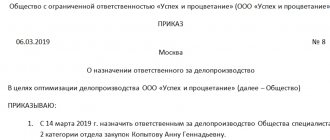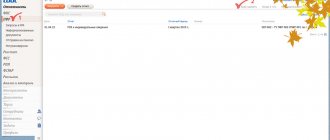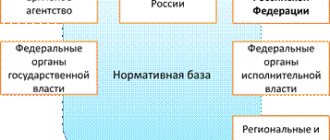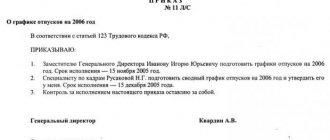In the work of any organization, situations may arise when important documents are constantly not processed and transferred to the recipient on time, incoming or outgoing correspondence is regularly lost, and company employees do not have a clear understanding of what operations need to be performed with documents.
Conducting office work using a specialized software solution 1C: Document Flow, created on the modern technology platform "1C: Enterprise", helps to avoid the above problems. The 1C program for document automation implements accounting for the movement of official documentation of organizations, taking into account the provisions of the legislation of the Russian Federation, the requirements of GOST and the traditions that have developed in the field of office work in our country and other countries.
This article discusses office work in 1C using the example of the 1C: Document Flow configuration, version KORP release 2.1.11.5.
The concepts of “office work” and “document flow”
From the point of view of GOST, “Office work” as a certain type of activity has a very clear definition, which can be found in the corresponding section of the system of standards. If we speak in the context of commercial activities, then office work can be considered as a business process accompanying the main activity, supporting documentation support for management processes and covering such areas as document flow, documentation, operational use and work with documents, as well as their storage.
Office work is divided into three stages:
- Creation of documents (documentation);
- Organizing the movement and recording of documents (document flow);
- Archiving and preservation of documents (archival work).
“Document flow”, from a business point of view, implies the organization of the movement of documents arising in the course of the main activities of the organization, which begins from the very moment when the document was created or received from the counterparty, and ends (or stops temporarily) with the completion of execution - sending the document to the appropriate recipients and (or) forwarding to the archive.
There are three main documentation streams:
- Coming from other organizations (incoming);
- Sent to contractors, partners, regulatory authorities, etc. (outgoing);
- Created directly within the company for use by employees in management and organizational processes (internal).
The movement of documents occurs along clear routes that are thought out and designed in advance. These routes fully reflect the processes of organizations aimed at achieving the final result. At the same time, the flow of documents is inextricably linked with work processes and is an integral part of them.
Let's define the terms
By an office management system we mean a set of organizational, informational, technical, technological measures that ensure documentation of the organization’s activities (creation of documents), receipt or sending of documents, their processing, storage and use.
Office work is a complex system, so to effectively organize work, it is not enough to put documents in folders and store them in cabinets or desks. Documents need to be systematized, registered, monitor their execution, determine their storage periods, formulate them into files, deposit them in an archive or destroy them after they have lost their value and the storage period established by regulations has expired. And all this must be done, guided by certain principles, according to certain rules, so that at any time the necessary document can be found and so that this document can be used as a legal basis for making management decisions, as evidence in court or for another purpose.
According to the definition set forth in clause 2.1 of GOST R 51141-98 “Office management and archiving. Terms and definitions,” office work (documentation support for management) is a branch of activity that provides documentation and organization of work with official documents. An almost similar definition is enshrined in GOST R ISO 15489-1-2007 “System of standards for information, library and publishing. Document management. General requirements": records management - a set of systematic and effective actions for the creation, use, storage and destruction of documents in organizations in order to prove the conduct of business (managerial) operations" (clause 3.20).
Documenting the activities of an organization (creating documents) is an activity in which almost all employees of the organization are engaged to one degree or another. Organization of work with documents (processing of documents, their storage, use) are types of activities that are performed by a specialized division of the organization or, if the organization is small, by an employee (document specialist, clerk) performing the functions of an organizer of work with documents or a document manager.
Incoming documents
The process of registering documents in the 1C program we are considering involves a document going through three stages: first, the document is entered into the database, then it is reviewed by an authorized person, and finally, the document is submitted for execution. All information about incoming documents is displayed in the corresponding journal. There you can perform all the necessary actions with them.
Incoming documents
Outgoing documents
Outgoing documents are created in two ways: proactively, as a response to an incoming document, or the 1C solution independently assigns the status “Reply sent” to the incoming document. That is, in 1C: Document Flow, incoming/outgoing documentation is compiled in chains for the convenience of further work with it, but, like internal ones, outgoing documents are separately displayed in the corresponding journal.
Outgoing documents
The company's clerk registers the document (assigns a registration number to it) after or before the outgoing document goes through the approval stage and is approved.
Free expert consultation
Natalia Sivorina
Consultant-analyst 1C
Thank you for your request!
A 1C specialist will contact you within 15 minutes.
Types of documents in 1C Document flow
To properly maintain records of transactions taking place within an organization, it is necessary to enter a certain grouping. All documents have their own direction - perhaps it is an internal note or an invoice for payment that came from a supplier. The documentation is divided into three streams so that work with them is carried out separately and does not overlap:
- Inbox
- Outgoing
- Domestic
Before information received in documentation from a partner moves to another partner (becomes an outgoing document), it must be processed. Access to the document is limited by the administrator, and each employee will change the status of the document in the program. As the status changes, it will move from department to department, and then an outgoing document will be issued on its basis.
Incoming documents
Incoming documents are those that come to the company from outside.
There are several sources:
- Mail;
- Email;
- Courier;
- Transfer by a representative of another company.
Each of these documents is registered and goes through three stages of processing:
- Primary registration (basic information is recorded that will help recognize the paper);
- Review (performed by one of the company’s employees);
- Execution (this stage may not exist).
In 1C you can record documentation that comes from individuals or legal entities. Incoming documents can be understood as an invoice for payment, a claim, etc. Each incoming request should be answered, but before that you will have to change several statuses for each request.
Firstly, when it reaches one of the organization’s employees, the documentation will be registered. It will receive a request status. During the review, the status should be set to “In Processing”, and after the decision is made, the processing approaches the “Execution” stage, and the status changes to “Response to request”.
Outgoing documents
An outgoing document means a paper that is drawn up within the organization for sending to partners or supervisory authorities. For example, using 1C, reports for the tax inspectorate are conveniently generated. It's easy here to create documents to create an order to a supplier and send a check to your customers.
Outgoing documentation can be a response to an incoming request or be created on its own. It is created in several stages:
- Creating text, indicating the type of document (request, demand, claim, complaint).
- Text approval and correction. Decision makers should review the resulting language and make corrections if necessary.
- Approval of the text. Once all decision makers agree with the adjustments made, you can move on to the next step.
- Registration in the system. The document is assigned a number, and the main fields are filled in, reflecting the essence and purpose of sending outgoing documentation.
In the 1C system, only the last stage of creation is recorded - registration. The identification number must be assigned by the responsible employee (usually the secretary) after the text has been agreed upon, adjusted and approved by the responsible persons. Before this, documentation traditionally existed only on paper.
If the outgoing document is a response to an incoming request, such documents are linked in the system. Before a decision is made, the incoming request will “wait” in the “Processing” status, and when the outgoing document is generated, this correspondence will be set to the “Response Sent” status.
Internal documents
Any movement of funds and materials must be documented. If you don’t record transactions or don’t register just one transaction, you can lose count and money or materials will “get lost.” The most reliable method of accounting is to use a computer program, including 1C.
Internal documentation may be part of the processing of incoming or outgoing requests. During the decision-making process, it is necessary to record the issue of goods or the authorization of payment of an invoice, because all these actions are part of processing requests. Internal documentation includes memos, orders and other important papers.
Internal documents
- Organizational and administrative;
- Official information and reference books;
- Office memos, personnel service documentation, various orders.
Grouping internal documents into folders facilitates the processes of office work, storage and retrieval.
Internal documents
All internal documents also go through the stages of coordination and approval. After this, they are sent to the company secretary, who finally registers them and assigns a number.
Outgoing correspondence 1C:8.2
An outgoing document can be created either in response to an incoming one or independently.
The registration number is assigned to the outgoing document by the secretary of the organization after its approval and approval by the authorized person.
If an outgoing document is created in response to an incoming one, the program will automatically assign the mark “Reply sent” to the incoming document.
During the processing process, outgoing documentation goes through stages that include direct creation, approval, approval by an authorized person and registration.
Incoming and outgoing correspondence is compiled by the program into chains.
Internal documentation
Internal documents are usually understood as organizational, administrative and informational and reference official documents. This includes orders, HR documents, memos, etc.
An internal document, like an outgoing one, is registered by the secretary of the organization and assigned a number after the document has been agreed upon and approved by an authorized person.
Document type
The type assigned to a document in the 1C program is one of its main characteristics.
Types of documents
Based on the type of document, the following are determined:
- Document execution deadline;
- What route will it be processed;
- What rules will be used to assign a number during the registration process?
1C Document Flow contains a mechanism for automatically maintaining lists of all incoming, outgoing and internal documents in the company.
INSTRUCTIONS for office work: ORGANIZATION OF DOCUMENTS IN OFFICE WORK
ORGANIZATION OF DOCUMENTS IN OFFICE PROCESS
The organization of documents in office work is a set of types of work that ensures the safety, recording, systematization of documents, the formation and registration of cases in office work and their transfer to the university archive (hereinafter referred to as the archive) in accordance with the requirements established by state standards for documents, normative and methodological documents of the Federal Archival Agency, as well as relevant regulatory and methodological documents on archival affairs and office work of the university.
The main types of work that ensure the correct organization of documents in office work are the compilation of a nomenclature of cases and the formation of cases.
7.1. Formation and registration of cases
7.1.1. Formation of cases - grouping executed documents into cases in accordance with the nomenclature of cases and systematization of documents within the case.
7.1.2. Control over the correct formation of cases is carried out by the clerical department of the DSU.
7.1.3. When creating cases, the following rules must be observed: place only executed documents in the case in accordance with the case headings according to the nomenclature; group documents of the same calendar year into a case, with the exception of transferable cases; separate permanent and temporary storage documents into files; place photocopies of faxes and telephone messages in files on a general basis; Documents that must be returned, extra copies, and drafts should not be included in the file; the volume of the file should not exceed 250 sheets. If there are several volumes (parts) in the case, the index and title of the case are placed on each volume with the addition of “vol. 1”, “2”, etc.
7.1.4. Documents within the case are arranged in chronological, question-logical sequence, or a combination of both.
Administrative documents are grouped into cases by type and chronology with related applications.
In separate cases, according to chronology, depending on the type of documents, copies of adopted federal and regional laws in the field of education, regulatory documents of the Ministry of Education and Science of Russia, the Federal Agency for Education, and the Federal Services for Supervision in Education and Science are compiled.
Documents from meetings of the Academic Council are grouped into one file.
Provisions and instructions approved by administrative documents are appendices to them and are grouped together with the specified documents.
Orders for core activities are grouped separately from orders for personnel.
The minutes in the file are arranged in chronological order by number. Documents for protocols, grouped into separate cases, are systematized by protocol numbers.
Approved plans, reports, estimates, limits, title lists and other documents are grouped separately from projects.
Documents in personal files are located as they are received.
Correspondence is grouped, as a rule, over a period of a calendar year and systematized in chronological order; The response document is placed behind the request document. When correspondence on a particular issue that began in the previous year is resumed, the documents are included in the current year's file, indicating the index of the previous year's file.
7.1.5. To record documents of certain categories of cases of permanent and temporary storage periods (over 10 years), the recording of which is caused by the specifics of this documentation (especially valuable, personal files, etc.), an internal inventory of case documents is compiled.
An internal inventory of case documents is also compiled for cases of permanent and temporary (over 10 years) storage, if they are formed according to types of documents, the headings of which do not reveal the specific content of the documents. The internal inventory is compiled on a separate sheet according to the established form, which contains information about the serial numbers of the case documents, their indexes, dates, headings and numbers of the sheets of the case on which each document is located. A final record is drawn up for the internal inventory, which indicates in numbers and in words the number of documents included in it and the number of sheets of the internal inventory.
The internal inventory of the case documents is signed by the compiler, indicating the transcript of the signature, position and date of compilation of the inventory. If the case is already bound and filed, then the internal inventory of the documents of the case, certified by the compiler, is pasted at the top edge to the inside of the front cover of the case.
7.1.6. The documents constituting the case are filed or bound, taking into account the possible free reading of the text of all documents. When preparing files for filing (binding), metal fasteners (pins, paper clips) are removed from the documents.
Cases of temporary (up to 10 years inclusive) storage may be stored in binders, do not re-systematize the documents in the case, do not number the sheets of the case, and do not draw up certification notes.
7.2. Organization of operational storage of documents
7.2.1. From the moment of establishment until transfer to the archive, files are stored at the place of their formation.
Heads of structural units and employees responsible for office work are required to ensure the safety of documents and files.
Files located in work rooms and rooms specially designated for this purpose are located in a vertical position with their spines facing outward in locked cabinets that ensure their complete safety, protecting documents from dust and exposure to sunlight.
In order to improve the operational search of documents, cases are arranged in accordance with the nomenclature of cases. The list of cases or an extract from it is placed on the inside of the cabinet.
Nomenclature indexes are indicated on the spines of case covers.
Completed files of permanent and long-term (over 10 years) storage periods are stored at the place of their formation for two years, and then handed over to the university archives.
Using advanced options
For each type and type of incoming documents in the standard 1C Document Flow solution we are considering, you can configure accounting according to additional parameters (details and information). The administrator and the user responsible for master data have access rights for such settings. For example, a document can be marked as current/irrelevant.
Paper document flow and office work, although not yet completely, but still to a significant extent, have lost out to paperless technologies, since the latter have proven their functionality and performance.
The office work we reviewed in 1C: Document Flow is capable (compared to office work in non-specialized solutions and, of course, compared to paper) to significantly simplify the accounting and storage of documentation in an organization, speed up the processing and execution of incoming/outgoing and internal documentation, set up customization flexible rules for assigning a registration number and keeping records of documents according to additional parameters.
To find out the price of 1C: Document Flow 8 and the possibility of implementing this configuration, contact our specialists. We will be happy to answer your questions.
About the course
The purpose of studying the discipline is to study the organization of effective office work in the context of the functioning of a modern enterprise, the formation of a system of theoretical information and practical knowledge on the preparation, editing and subsequent processing of documents taking into account the requirements of the current Russian legislation.
Objectives of the discipline:
— study of the normative and methodological base of office work;
— development and application of standards of a unified system of organizational and administrative documentation;
— developing skills in working with documents in strict accordance with existing regulations in this area;
— studying the details of organizational and administrative documentation in accordance with GOST R 7.0.97 – 2020.
— drawing up administrative, reference and informational and other documents in accordance with GOST R 7.0.97 – 2020.
— study and analysis of the organization of a rational document flow system;
— research into methods of conducting computer document flow, regulated by current regulatory documents on office work;
— study of the organization of archival storage of documents.









